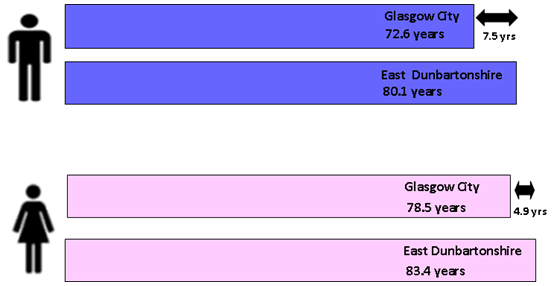Wide variation in life expectancy between areas in Scotland
Wide variation in life expectancy between areas in Scotland

Life expectancy at birth varies considerably for areas in Scotland, according to a report published today by the National Records of Scotland (NRS) which breaks down by administrative area the Scotland level estimates published on 21 March.
Based on statistics covering 2010-2012, the report shows that life expectancy differs by up to 7.5 years for males and up to 4.9 years for females between Council areas in Scotland.
Registrar General for Scotland and NRS Chief Executive Tim Ellis said:
“The figures published today tell us that life expectancy at birth in Scotland is at its highest ever level and the gap between males and females is closing. But there are significant differences in life expectancy depending on which part of Scotland you live in. For example, life expectancy for a baby born in East Dunbartonshire is 7.5 years more for a boy and 4.9 years more for a girl than for a baby born in Glasgow City.”
Main findings from the statistics released today
At birth
-
Life expectancy in Scotland was 76.6 years for males and 80.8 years for females but with considerable variation between areas.
-
Male and female life expectancy was highest in East Dunbartonshire Council area and lowest in Glasgow City Council area. Males in East Dunbartonshire can expect to live for 80.1 years, 7.5 years longer than in Glasgow City (72.6 years). Females in East Dunbartonshire can expect to live for 83.4 years, 4.9 years longer than in Glasgow City (78.5 years).
Life expectancy at birth, Scotland 2010-2012
Compared with UK and Europe
-
Scottish males and females have the lowest life expectancy at birth in the United Kingdom (UK). Male life expectancy is 2.3 years lower than the UK average and female life expectancy is 1.9 years lower.
-
In Scotland, males and females can expect to live shorter lives (by 2.6 years and 2.2 years respectively) than in England, where male and female life expectancy is the highest in the UK.
-
Within the UK in 2010-2012, male life expectancy was highest in East Dorset and Hart, both (82.9 years) and lowest in Glasgow City (72.6 years). For females, life expectancy at birth was highest in Purbeck at 86.6 years and lowest in Glasgow City where females can expect to live for 78.5 years. The Council areas higher for males and females are all in England.
-
Amongst European Union (EU) countries, male life expectancy was highest in Sweden (79.9 years), 3.3 years higher than in Scotland. Female life expectancy was highest in France (85.7 years), 4.9 years higher than in Scotland.
Changes over time
-
Male and female life expectancy has continued to rise across Scotland.
-
The biggest improvements in male life expectancy since 2000-2002 have been in Orkney Islands Council and NHS Board area (4.3 years).
-
The biggest improvements in female life expectancy since 2000-2002 have been in East Dunbartonshire Council area, increasing by 2.9 years and Highland NHS Board area, increasing by 2.5 years.
-
The gap between male and female life expectancy at birth in Scotland has decreased from 6.2 years in 1981-1983 to 4.2 years in 2010-2012. Male life expectancy has been increasing at a faster rate than for females since 2001-2003.
At age 65
-
Males in Scotland could expect to live for a further 17.2 years and females a further 19.5 years.
-
Orkney Islands Council area had the highest male life expectancy at age 65 (19.4 years), 4.5 years higher than in Glasgow City, where it was lowest at 14.9 years. Female life expectancy at age 65 was highest in East Dunbartonshire (21.5 years) and lowest in Glasgow City (18.3 years), a difference of 3.2 years.
The full publication Life Expectancy for Administrative Areas within Scotland 2010-2012 is available on the NRS website.
